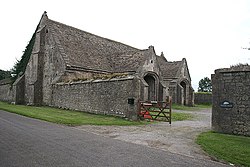| Tithe Barn, Manor Farm | |
|---|---|
 | |
| General information | |
| Town or city | Doulting |
| Country | England |
| Coordinates | 51°11′07″N2°30′20″W / 51.1854°N 2.5056°W |
| Completed | 15th century |
The Tithe Barn at Manor Farm (also known as Abbey Barn) in Doulting, Somerset, England, was built in the 15th century, and has been designated as a Grade I listed building, [1] [2] and scheduled as an ancient monument. [3]
Tithe barns were used to store tithes, from the local farmers to the ecclesiastical landlords. In this case the landlord was Glastonbury Abbey. [4] A tithe (from Old English teogoþa "tenth") is a one-tenth part of something, paid as a (usually) voluntary contribution or as a tax or levy, usually to support a Christian religious organization.
The stone barn has eight bays supported by buttresses and two wagon porches. [4] [3] The cruck roof trusses, at both ends of the barn, have timbers which have been shown by dendrochronology to have been felled between 1288 and 1290. [5] [6] There are some curved windbraces. [2]
The stonework is showing signs water damage and erosion at the base of the walls. [7]
